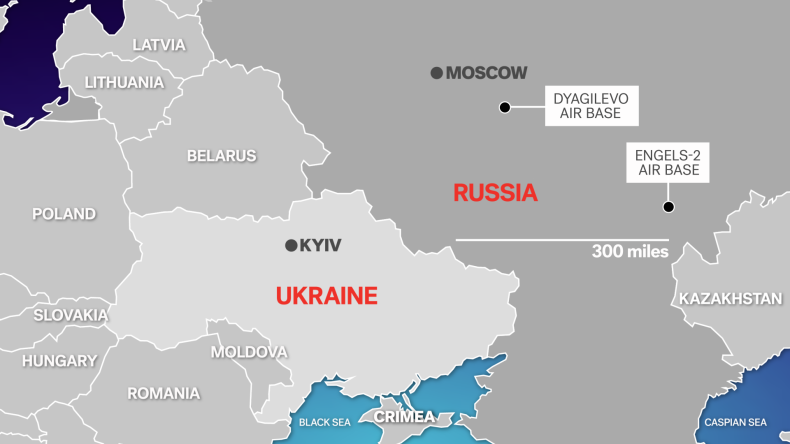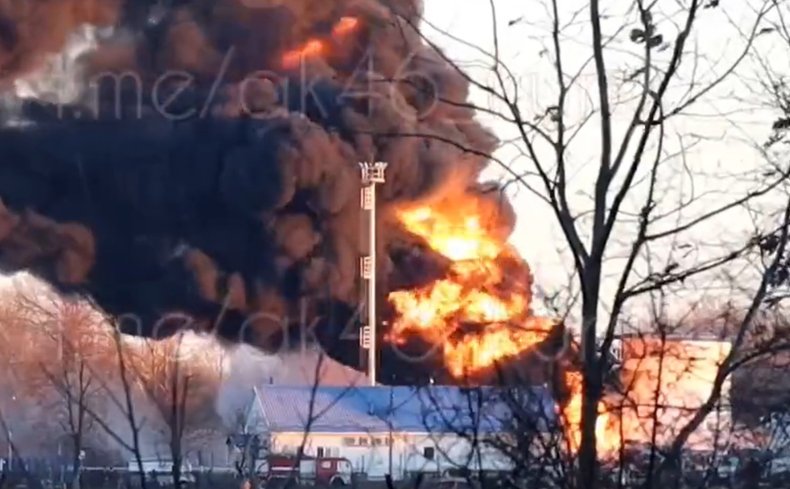BRENDAN COLE
Drone strikes deep inside Russian territory reportedly carried out by Ukraine could cause some sleepless nights for those in Vladimir Putin's inner circle.
In the latest audacious attack, an oil storage container at an airfield near Kursk was hit on Wednesday, according to local Governor Roman Starovoit, in what was the second such strike in his region in as many days.
The Kursk oblast borders Ukraine but attacks much further inside Russia have shown that Kyiv could also be looking far from the front lines of the conflict to give Moscow a bloody nose.
Videos and social media posts have shown the aftermath of strikes on Monday at airfields at Dyagilevo in the Ryazan region and Engels in the Saratov region. The Engels air base is around 450 miles from Ukraine, while the Dyagilevo base is around 400 miles from the frontier.
 This Newsweek graphic shows the areas inside Russia that were struck by what Moscow has said were drones sent by Ukraine. The strikes hit the Kursk, Ryazan and Saratov regions.NEWSWEEK
This Newsweek graphic shows the areas inside Russia that were struck by what Moscow has said were drones sent by Ukraine. The strikes hit the Kursk, Ryazan and Saratov regions.NEWSWEEK"They very possibly just demonstrated a new capability to hit anywhere in Russia," said retired U.S. Army Major John Spencer, a leading urban warfare expert, who described these strikes as a "very big moment in the war."
Russia's defense ministry accused Kyiv of using Soviet-era drones in the attacks which aimed "to disable Russian long-range aircraft." Some experts have said the drones referred to are Tu-141s, which were developed by the Soviet military in the 1970s and 1980s.
Kyiv has not directly claimed responsibility for the strikes but has celebrated them. A senior Ukrainian official told ABC News that Ukrainian special forces were deep inside Russian territory and helped guide drones to at least one of the bases hit.
"If Ukraine truly has the ability to send drones over 600 kilometers into Russia to strike at their strategic military capability," Spencer told Newsweek, "it will mean Russia will have to use a lot of resources, [such as] manpower, air defense capabilities, to defend a lot of sites they falsely believed were untouchable."
He said it showed weaknesses in Russian airspace and it was "very smart" for Ukraine to hit military locations, rather than the civilian infrastructure that Moscow's forces have targeted, which has led to widespread blackouts.
"Now the Russian government must decide what capabilities, possibly out of Ukraine at least in the near term, have to be repositioned to prevent these types of attacks from happening again," said Spencer, who is Chair of Urban Warfare Studies with the Madison Policy Forum.
Senior western officials cited by Reuters said on Tuesday that the attacks were the furthest inside Russia since the war began and so will have struck a "psychological blow, as Moscow would have to consider how to keep its long-range, nuclear-capable bombers safe.
"Overall, this attack is symbolic, but it carries more psychological than strategic significance," said Dale Buckner, CEO of international security firm Global Guardian. "It is unlikely that this method of attack will become a mainstay in Ukraine's toolkit."
He told Newsweek that like the aftermath of the attack on the Kerch Strait bridge linking Crimea to Russia, Moscow "will likely seek to escalate the conflict in a punitive and visible way."
"It's very unclear what Russia will do immediately other than continuing its assault on Ukraine's grid," he said, "but sooner than later Russia may choose to deploy tens of thousands more Russian mobiles currently training in Belarus into Ukraine."
 This screen grab from Twitter shows an explosion at an airfield in Kursk, Russia, following a drone attack on December 6, 2022. Moscow has accused Kyiv of conducting drone strikes in areas well inside Russia.TWITTER
This screen grab from Twitter shows an explosion at an airfield in Kursk, Russia, following a drone attack on December 6, 2022. Moscow has accused Kyiv of conducting drone strikes in areas well inside Russia.TWITTERState-owned weapons manufacturer Ukroboronprom has recently indicated it is close to finishing work on a new long-range drone. In October, it posted on Facebook what appeared to be the device's structure which it said had a range of 1,000 km (620 miles), although there is no indication that the drone is ready for deployment.
"Ukraine likely has limited stocks of long-range drones but will almost certainly be rapidly developing more," said former British military intelligence officer Philip Ingram.
He told Newsweek that Kyiv would want to counter Russia's missile attacks on civilian infrastructure across Ukraine "with deniable strikes back into Russia—not huge numbers, but enough to send a message that nowhere is safe."
Marcel Van Herpen, the author of Putin's Wars and director of the Dutch think tank, the Cicero Foundation, said that the strikes show Ukraine's ability to organize a forward defense without the help of the U.S.-supplied High Mobility Artillery Rocket Systems (HIMARS).
"Some Western governments may fear a tactical nuclear response. However, this is exaggerated," he told Newsweek.
"It would bring only more problems for Moscow, isolating it internationally, while it doesn't bring a victory on the battlefield. Moscow's reaction will remain restricted to some 'punitive actions,'" he said.
No comments:
Post a Comment